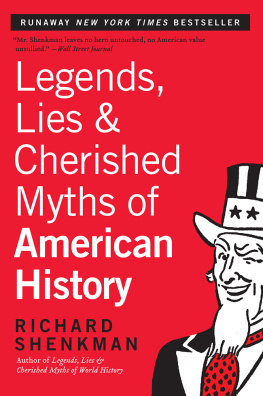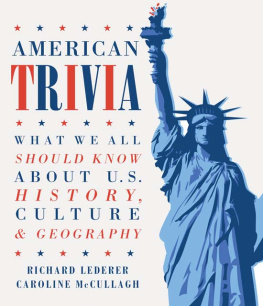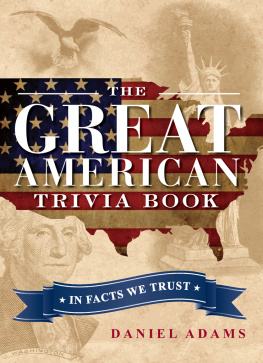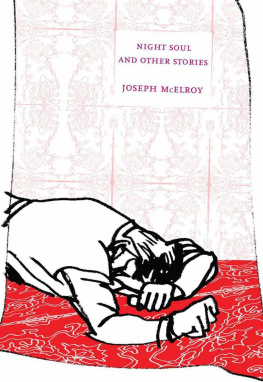One-Night Stands
with
American
History
Odd, Amusing, and Little-Known Incidents (Revised Edition)
Richard Shenkman and Kurt Reiger

T HIS EDITION IS DEDICATED TO
OUR PARENTS;
C RISTI , H ALLIE B RUGGE, AND E LLIOTT F REI R EIGER;
AND
J OHN S TUCKY
Contents
Everybody likes a good story or an interesting odd fact. This is a book of themstories about inventions, presidential secrets, hoaxes, rare incidents, and cultural idiosyncrasies. It is not a book of tall tales in the genre of Paul Bunyan or Johnny Appleseed. The great majority of the stories are not well known and will surprise even professional historians. We found them by searching through biographies and histories and by asking specialists in American history for suggestions. While all of the odd facts are true, some of the anecdotes are questionable, but we have included only those which strike a chord of verisimilitude. A few of them are clearly apocryphal, such as a story by Parson Weems, but they are included here because they are characteristically American.
Puritanism: The haunting fear that someone, somewhere, may be happy.
H. L. M ENCKEN
SCRAPBOOK OF THE TIMES
In 1631, Massachusetts Bay outlawed chimneys made of wood after major fires ravaged several towns.
Concerned about the fluctuating value of money, Willem Kiefft, deputy-general of New Amsterdam, issued an order in the 1640s that wampum be strung tightly together. Loose wampum had created problems of exchange and led to an increase in bartering.
The first income tax in American history was imposed in 1643 by the colonists of New Plymouth, Massachusetts.
Wall Street received its name in 1644, when New York City built a wall around lower Manhattan to protect cattle from marauding Indians.
The first person convicted and executed in America for witchcraft was Margaret James of Charlestown, Massachusetts. She was executed on June 15, 1648, almost fifty years before the notorious trials at Salem.
When inflation became a major problem in the 1650s in New Amsterdam, Peter Stuyvesant, head of the colony, imposed price controlsat first just on bread, brandy, and wine, and later on shoes, stockings, soap, salad oil, candles, vinegar, and nails.
The first Bible was printed in America in 1661in the Algonquin language, a language that no one today can read.
In the seventeenth century New Englanders spoke with a Southern accent. The Southern accent was a survival from old England and predominated in America until the eighteenth century, when Yankees began speaking with the familiar twang.
For wearing silk clothes, which were above their station, thirty young men were arrested in 1675 in New England. Thirty-eight women were arrested for the same offense in Connecticut.
To celebrate the end of King Philips War, the worst Indian war in their history, New England colonists, on August 17, 1676, placed the head of the man who started it, Chief Metacomet, on a pole outside the gates of Plymouth. The head remained there for twenty-five years.
The rhymes of Mother Goose, a real person, were first published in 1719 under the title Songs for the Nursery; or, Mother Gooses Melodies for Children. Her son-in-law, a printer, who was annoyed by the rhymes Mother Goose sang to his baby, published them in an attempt to embarrass her.
Women were in such short supply in Louisiana in 1721 that the government of France shipped twenty-five prostitutes to the colony. By this action the government hoped to lure Canadian settlers away from Indian mistresses.
Angered by the poor quality of dormitory food, students at Harvard College rebelled in 1766. The administration responded by suspending half the student body.
COLUMBUSS SECRET LOG
On September 9, 1492, as the last land dropped below the horizon, Christopher Columbus began keeping two logs. One log, which he kept secret, was a true reckoning of his course and distance. The other was a falsified account of the ships location written so the crew would not be frightened at sailing so far from land. Yet as fate would have it, Columbus overestimated his distance by 9 percent in his private log, placing his discovery much farther west than it actually was. The false log, however, contained no such error. Columbus had given his sailors a record that was, for all practical purposes, virtually correct.
S OURCE: Samuel E. Morison, Christopher Columbus (Boston: Mentor, 1955), p. 36.
TOBACCO: SIXTEENTH-CENTURY PANACEA
A relationship between smoking and health was recognized soon after the introduction of tobacco to Europeans. In 1588, Thomas Hariot published A Brief and True Report of the New Found Land of Virginia, in which he described the new product to the Old World. It openeth all the pores and passages of the body, he wrote. Users are notably [preserved] in health, and know not many greevous diseases wherewithall wee in England are oftentimes afflicted.
S OURCE : Thomas Hariot, A Brief and True Report of the New Found Land of Virginia (1588; rpt. Ann Arbor, Mich.: Edwards Brothers, 1931), p. 63.
A NAMING IN THE NEW WORLD
Plymouth, Massachusetts, was named by the Pilgrims in 1620 because the Mayflower had sailed from Plymouth, England. It sounds logical and is believed by most people, but it isnt true. In 1614, Captain John Smith sailed from Jamestown, Virginia, on his first exploring mission to the northeast. He returned with a map cluttered with barbarous names representing Indian villages. Smith showed the map to Prince Charles and asked His Royal Highness to provide good English names in place of the Indian ones. Prince Charles obliged, and changed the Indian name of Accomack to Plymouth, years before any white man ever settled there.
S OURCE: All the People Some of the Time (Ann Arbor, Mich.: William L. Clements Library, 1941), p. 8.
THE PILGRIMS DIDNT LAND ON THE ROCK
The belief that the Pilgrims landed on Plymouth Rock rests solely on the recollection of a ninety-five-year-old man 120 years after the event. In 1741, Elder Thomas Faunce told a crowd that his father, who arrived in America three years after the Mayflower, had once pointed out to him the rock as the place where the Pilgrims had landed. There is no other evidence for the tradition. Besides, the Harvard historian Edward Channing proved that the ship never could have landed at the rock given the direction of the current.
S OURCES : Arthur Lord, Plymouth and the Pilgrims (Boston: Houghton Mifflin, 1920), pp. 12021; Samuel E. Morison, By Land and by Sea (New York: Knopf, 1953), p. 307.
REDS IN PLYMOUTH
When the Pilgrims arrived in America in 1620, they immediately committed an un-American actat least, one that would be so viewed later on. Desiring to create a just and equal society, they established a communist economy. The early colonists remained committed to communism for several years, until they finally decided that it was inefficient. Their switch to capitalism was a defeat of sorts, since it implied the inability of men to work hard for the common good without individual incentive.
S OURCE : William Bradford, Of Plymouth Plantation, ed. Harvey Wish (New York: Capricorn Books, 1962), p. 90.
BOY EXECUTED FOR BUGGERY
Strange as it may sound, in 1642 the Pilgrim colony at Plymouth, Massachusetts, was struck by a crime wave. William Bradford, governor of the colony, described in his history of Plymouth one of the worst crimes:
Ther was a youth whose name was Thomas Granger; he was servant to an honest man of Duxbery, being aboute 16. or 17. years of age. (His father & mother lived at the same time at Sityate.) He was this year detected of buggery (and indicted for the same) with a mare, a cowe, tow goats, five sheep, 2. calves, and a turkey. Horrible it is to mention, but the truth of the historie requires it. He was first discovered by one that accidentally saw his lewd practise towards the mare. (I forbear perticulers.) Being upon it examined and committed, in the end he not only confest the fact with that beast at that time, but sundrie times before, and at severall times with all the rest of the forenamed in his indictmente.... And accordingly he was cast by the jury, and condemned, and after executed the 8. of September, 1642. A very sade spectakle it was; for first the mare, and then the cowe, and the rest of the lesser catle, were kild before his face, according to the law, Levit: 20:15, and then he him selfe was executed.
Next page











